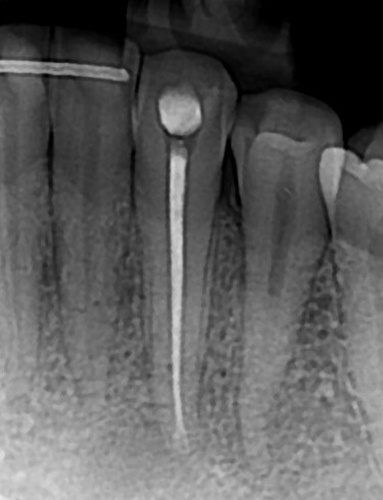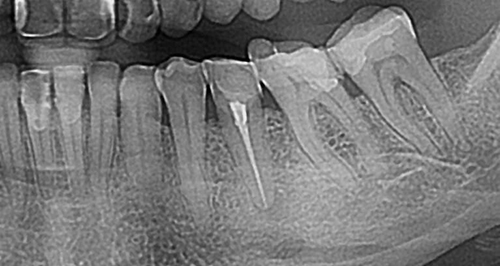What is endodontics?
Endodontics is a branch of dentistry that deals with treating pathological processes within the dental pulp. It is a sort of microsurgical treatment which requires micron precision in tight and invisible areas such as the inner parts of the tooth’s cavity.
What is endodontic therapy?
Endodontic therapy (endodontic treatment, root canal treatment, “nerve removal”) includes treating pathological processes in the pulp. It is one of the most common dental treatments.
What is dental pulp and when does it require treatment?
Dental pulp is the soft tissue of the tooth chamber within the tooth crown and inside root canals. Our teeth are composed of hard tissues (enamel, dentin, cementum) and soft tissues (pulp). The pulp tissue, which is composed of nerve bundles, blood vessels and other supporting tissues, provides the vitality to the tooth. It is responsible for transmitting impulses and supplying surrounding tissues with nutrients. The pulp tissue requires treatment when it is inflamed (pulp inflammation) or necrotic. The pulp infection is caused by bacteria and bacterial toxins penetrating into the tooth cavity (due to untreated caries or trauma).
What is pulpitis and what causes it?
Pulpitis is inflammation of the dental pulp. It is most commonly caused by deep caries. If caries is not treated on time, bacteria and their products destroy the hard tissue of the tooth and enter the pulp chamber, causing pulp irritation and consequently, pulp inflammation. Pulpitis can be acute and chronic. Acute inflammation usually starts with increased tooth sensitivity to thermal stimuli (hot, cold), biting and pressure. In chronic pulpitis, on the other hand, tooth vitality is gradually lost (necrosis), without any symptoms or pain, the only sign of a dead tooth being a change in its colour. Similarly, a tooth may also gradually die after trauma.
What are symptoms of pulpitis?
At the beginning of the acute phase, pulpitis is manifested through symptoms of hypersensitivity to external stimuli (hot, cold, biting). Usually throbbing pain develops which is difficult to regulate even by taking analgesics. As opposed to acute inflammation which is characterized by sharp pain, chronic inflammation develops slowly and gradually, with no obvious symptoms, leading to pulp necrosis. Around the apex of a tooth’s root (periapex) granuloma is formed as the body’s response to inflammation in an attempt to restore balance and localize the inflammation to periapical area. Granuloma can stand still or grow slowly without any symptoms, or a fistula (gum boil) can form on the surface of the gum in the projection of the root tip. If defence mechanisms cannot fight bacteria, acute periapical process develops and the toothache appears. The inflammation spreads into the bone and enters the soft tissue, which results in a face swelling (abscess = a localized collection of pus). Apart from using endodontic therapy to treat this condition, it can also be treated with incision and antibiotics, if necessary. If the tooth which is the source of infection cannot be endodontically treated, tooth extraction will be necessary. Such infection in the lower jaw is particularly dangerous since this located abscess may develop into a diffuse suppurative inflammation which is life-threatening. Pulp inflammation should, therefore, be recognized and treated on time. Apart from the aforementioned symptoms, the presence of the periapical inflammation as the focus of infection can be linked to other diseases, such as heart disease, kidney problems, different diseases of joints, skin…
What is the procedure of endodontic treatment?
Endodontic treatment includes removing the pulp with pathological changes from the pulp chamber and the root canals (endodontic space) and filling this space by artificial materials to ensure its sealing and thus prevent further bacterial penetration. The procedure follows:
- After the initial examination, the diagnosis is established based on the medical history, clinical extraoral and intraoral examination and the X-ray analysis. If we determine a diagnosis of pulpitis or periapical process and vitality tests show the tooth is nonvital, endodontic treatment and tooth reconstruction plans are made. An X-ray is required since it gives us an insight into morphological features of the tooth and tells us whether (and to what extent) a pathological process is present in the periradicular area (around the root of the tooth).
- The treatment includes opening the affected tooth under anaesthesia (acute inflammation) and removing the infected tissue from the tooth’s cavity. The inflamed or necrotic tissue from the pulp chamber and root canals is removed by specially designed hand or machine instruments and by rinsing with antiseptic solutions. Root canals are then filled by materials that will ensure sealing of the endodontic space and prevent reinfections.
- After the endodontic treatment, the tooth needs to be restored by a filling, or in the case of extensive reconstruction of the tooth crown, by a core build-up and a crown. Restoring the endodontically treated tooth in this way provides it with longevity, functionality and aesthetics.
How many visits does endodontic treatment require?
In most cases, modern endodontics enables painless endodontic treatments in 1 -3 office visits.
Can all teeth be treated endodontically?
Unfortunately, there are reasons why some teeth are more difficult than others to treat endodontically. Most commonly those teeth are the teeth with complex root canal anatomy which makes them less accessible to endodontic instruments. When it is difficult to access the root canal, the whole procedure is longer and more challenging, and it is often not possible to clean all root canal walls. For instance, a canal may be severely curved at the tip of the root and therefore inaccessible to instruments. In such cases it is difficult to bend instruments which may even break or damage the root canal walls. Sometimes it is not possible to clean the whole canal successfully, so there is a possibility of later periapical inflammation occurrence. In that case, endodontic treatment may be repeated (the so-called revision). If the inflammation persists even after the revision, a surgical removal of the tip of the root (apicoectomy) may be attempted. However, when it is not possible to perform apicoectomy, or it may not produce any results, the tooth cannot be treated again and the extraction is required. Sometimes, due to extensive periapical inflammation and/ or abscess, tooth extraction is the only option before even attempting to perform the endodontic treatment.
What is the revision of endodontic filling?
The revision of the endodontic filling is a repeated endodontic treatment of the previously treated tooth. The most common reason for the failure of the initial endodontic treatment is the presence of bacteria in the root canal or periapical area (bone tissue surrounding the tip of the root), which happens as a consequence of the coronal (through the tooth’s crown) or apical (through the tip of the root) leakage due to inadequate filling and sealing of the tooth. Repeated periapical process causes reappearance of the tooth sensitivity to biting and other symptoms of the inflammation. This can happen after a shorter or longer time period. The therapy includes repeated root canal cleaning and disinfecting, as well as placing a retrograde filling and tooth crown restoration. In cases where a more demanding initial endodontic treatment was performed, a more demanding revision can be expected as well, with more difficulties and complications. The revision of endodontic filling might not always be successful.
What to do after endodontic treatment?
The tooth that has undergone endodontic treatment may still display symptoms of sensitivity to biting or a light pain, but this is a normal reaction. It is important to see that pain is gradually decreasing, and not increasing. After a few days it completely disappears. More sensitive people can take some analgesics, if instructed by their dentist. A successfully treated tooth can function as well as a healthy tooth. Still, we should be aware of the fact that a treated tooth gradually loses its hydration and elasticity, becomes fragile and might break, if under pressure. In time, these teeth can also become darker. Therefore, apart from restoring endodontically treated teeth by adequate tooth fillings (when there is sufficient tooth structure) or post and core build-ups and crowns (when there is extensive coronal loss) to prevent coronal leakage and reinfections, we should also cover them by aesthetic crowns in order to decrease the risk of tooth/root fractures.
Why choose endodontic treatment in OUR practice?
- We have 17 years of experience in performing endodontic treatments.
- Each step of the procedure will be explained to you, you will be informed about all the advantages and risks of the treatment.
- The work in your mouth will be painless and safe, we will do our best to make it as comfortable as possible and our service as good.
- We try to make you feel comfortable and relaxed in our office,without any fear.
- Endodontic treatment will be performed by using high quality materials.
- Following the endodontic treatment, if agreed with you, the tooth will be reconstructed into its natural form using procedures and materials that suit You best to make it functionally and aesthetically perfect.
- At any moment we are available to you for advice and consultation via mobile phone, e-mail and social media.
- We try to keep our appointments.
- You can pay in cash, but also in interest free instalments: American Express up to 12 instalments, Diners up to 6 instalments, Erste & Steiermärkische bank Maestro and MasterCard up to 12 instalments.
- There is free parking in front of the office.
If we meet your criteria, feel free to contact us and make an appointment.
If these pages do not provide you with an answer to your question on endodontic treatment, dental health and dental services, feel free to contact us.
We are at your disposal!
| Radno vrijeme
PON, SRI, PET 9:00-16:00
UTO, ČET 13:30-20:30
☎ +385(0)1 4822 137








